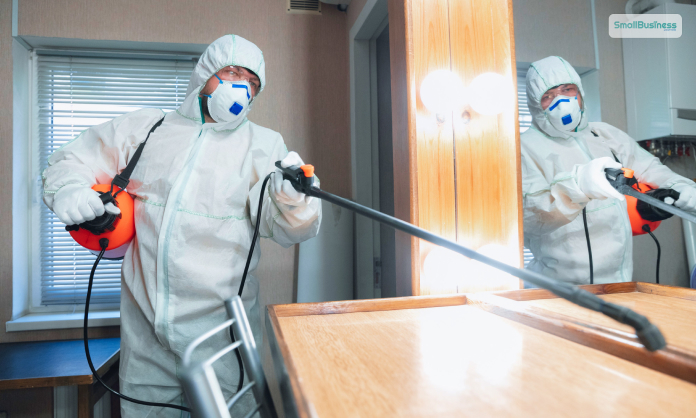How to start a pest control business?
Pests are quite harmful. Whether it is under your bedsheets, crawling around the kitchen basin, or inside your office desks. Rodents and pests spread different types of diseases and infections. In fact, the rapid climate change has spurred the growth of different types of insects. The solution to this global problem lies with successful pest control businesses.
It’s a billion-dollar industry that has been growing rapidly for the past few years. Experts hope that the pest control industry will grow up to $28 billion by 2026. Pest control businesses are firms that serve both residential and commercial clients.
And the clients are ready to spend the necessary amount to get rid of infection spread by pests. So, if you are thinking of starting a pest control business, there’s an opportunity. But how do you grab that opportunity? Here’s a step-by-step guide –
Ideate: Pest Control Busines Planning

Before you enter the pest control industry, it’s imperative to understand if you are going in the right direction.
1. Why? Pest Control Market Assessment
It’s ok if you are looking for a good income source from a pest control business. However, a money-making mindset isn’t enough to be successful in this business. The market is populated by strong competitors who have been providing their services locally and nationally for years.
So, it’s important to know why do you want to enter the pest control industry. Similar to any other business, it’s critical to have your purpose clear. Are your immediate competitors leaving a gap behind? What services do your target customers need? Do you have a unique pricing strategy? Are you using eco-friendly pesticides?
Some of your competitors might be slow to respond, or some of their services may not be for residential clients who want affordable services. It’s important to understand why your customers will consider your business for their pest control needs.
Your pest control business success is embedded into this idea, where you set your business apart from your immediate competitors. So, the first step is to understand why you are starting a pest control business.
2. What? Value You are Binging to the Table
How to start a pest control business? So, we are at the second phase, where you think about the services you are providing to your target customer. Pest control businesses help their customers exterminate pests, rodents, and vermin both on the inside and outside of their property.
The value they bring to the table is associated with their methods for extermination and pest control. These can be by implementing traps, physical removals, and sprays. Are your customer getting their money’s worth? Ensure that you are clear about the values your business provides to your customers.
3. Who? Target Customer Research

Here’s what can get wrong with your pest control business – you have a startup capital, and you invest in the necessary equipment, expecting people to come knocking at your door. Who are the clients you are starting your business for? It’s important to determine who your target customers are. When you know your potential customers, you are able to build the right services and craft the right marketing strategies for them.
As you look for your immediate competitors, you should also have some idea of who your customers are. Here, we have some pictures of who your customers can be –
- Landlords & Homeowners
- Hospitals, schools, restaurants
- People with pets
- Office buildings
When you determine who your target audiences are, you’ll have a better understanding of who your customers can be.
4. Where? Choose A Location For Your Pest Control Busines
Pest control is a small business. You can start your journey from home. But, as your business grows in size, you are likely to move to a bigger place to accommodate your equipment and employees. But, the location where you set up your commercial workspace is very important. It should be accessible to your target customers. Remember the following points as you choose a location for your pest control business workspace –
- The location should be accessible via public transport.
- Your workspace should have natural light and be spacious.
- Is the lease period flexible? Does it come with an extension period if you need one?
- Your workspace should be ready to use. If it requires a renovation or repairs, then you’ll be breaking the bank.
5. Be Part of a Franchise/ Or Do Your Own Thing?
In any business, it’s difficult to weed out the competition in any industry. The pest control industry is too competitive, and it’s not easy for a newcomer to the market to battle the competition. But it’s not impossible. However, there’s a proven way to success.
You can buy a pest control franchise and follow the proven track record, business model, and strategies to succeed. However, the initial investment can be sizable. If you are more into a low-cost startup, then you have to build your pest control business from scratch. You have to select if you want to start a franchise or a business from scratch.
6. Write a Business Plan

If you have decided to start a pest control business from scratch, get ready to write the business plan. This is a document that includes why you are starting the business, who your customers are, what your business strategy success is, etc. So, how to write your pest control business plan? Follow these steps –
Pest Control Business Plan
- Executive summary: Include your vision and your strategy for running a pest control business. This part of the business plan should include your mission, financial highlights, and business objectives.
- Business Overview: The business overview section includes your vision and the market problems your business is set to solve.
- Product and Services: here, you include the specific details regarding the services you offer through your business. It should also include pest identification, treatment methods, and different additional services such as inspection and prevention.
- Market Analysis: Your pest control business plan should also include a market analysis. Include facts about who your target customers are, market trends, and growth potential in the pest control industry.
- Competitive Analysis: include who your business competitors are and what their strengths and weaknesses are. Also, write about strategies to differentiate your business from your competitors.
- Sales & Marketing: Your pest control sales and marketing strategies should be included in this section of the business plan you draft. Include the channels you’ll use, promotional activities, and your methods for advertising.
- Management Team: write an overview of the people who will handle different parts of your business responsibility. This includes different roles and qualifications needed for those roles.
- Operation: the operation part includes how you will operate this business, from getting equipment to staffing, facilities, and more.
- Financial Plan: your business plan should also have a financial plan including the revenue forecasts and profit and loss statement. It is a comprehensive view of the financial viability of your business.
- Appendix: add all the additional documents, information, detailed market research, and other necessary information in the appendix part of your pest control business plan.
Start: Establishing Your Business
So, you have your business plan ready; now what? Now, you brainstorm and decide on a name for your pest control business.
7. Choose Your Business Name
How to find a name best suited for your pest control business? Here are the steps you can follow –
- The best idea would be to look inside your business plan. You can use the most unique aspect of your business as a business name. It can be a specific area of service or about a specific type of pests you control.
- Look for words that convert your audiences and build trust. Look for names that are effective and helpful.
- Ensure you pick a name that’s short, unique, and easy to remember.
- Try checking out your competitors if you run out of ideas. Once you check out the popular names your competitors are using, you’ll have some idea of what name suits your business the best.
- Ask your friends, keens, and family members for feedback about the name that you choose.
- Don’t go for complex words, jargon, and words that are too obscure. You are starting a business to help your potential customers, not to sound funny and quirky.
- Your business name should reflect the core values and mission your business is here to follow.
- If it feels too daunting of a task, then you can use business name generators to draft name ideas. Then, finalize whatever name suits you best.
8.Get Your Pest Control Busines Domain
Now that you have your business name ready, it’s time to choose a domain of the same name. A business name should be very well thought out. It is the name you will use for your business website, social media channels, and for campaigns.
Go to a domain-providing platform such as GoDaddy to find the domain with the same name as your business. It’s too difficult to find a domain name for common business terms. So, ensure that your name is a little creative, which helps find a domain for a cheaper price.
9.Incorporation: Register Your Pest Control Busines
Once your business name and domain names are ready, it’s time to register your business as a legal structure. The USA government makes it mandatory to choose a legal structure to shape your business as a legal entity. These structures assign different levels of liabilities and profits on the owner’s part. Read about the different structures below and choose wisely.
Sole Proprietorship: for sole proprietors, the liabilities and profits both go to the owner. The owner is the sole person who enjoys the profits and also carries the liabilities. This structure does not make any distinctions between the business and the owner.
General Proprietorship: This structure is similar to that of a sole proprietor. But, it involves more than two people in the business.
LLC: An LLC is the most suggested business structure for small businesses, such as pest control. Under an LLC, the business owner is not liable for the business debts.
C Corp Business: Under a C Corp, the business itself is an entity, and the owners are not liable for the profits and losses of the business. They earn their profits through shareholder dividends.
For a small pest control business, it’s best to consider an LLC as your business structure to gain considerable tax benefits.
10. Get Your EIN
Employer Identification Number is important for small businesses. There are both online and offline processes for applying for your business EIN. Getting your EIN is the process of getting ready for your business tax filing.
11. Get Funding: Fund Your Pest Control Business
Pest control is a low-cost startup idea. If you are not buying a franchise, then you don’t need too much money for the startup. If you don’t have enough savings to fund the minimum startup cost, you can try different ways to get funding for your pest control business. For example, you may look for –
- SBA guaranteed loans
- Government Grants
- Friends & Family
- Crowdfunding, etc.
12. Obtain Licenses
The next step in starting your pest control business is to get the necessary licenses and permits. The state, local, and federal governments have some regulations that every business operating in the USA has to follow.
Most small businesses are usually required to have the following licenses and permits –
- Health license from OSHA
- Copyrights
- Trademarks
- Patents
- Permits
However, your state and city laws and regulations might be different from those of the other states. In that case, you might need specific permits which don’t apply to other states.
We suggest checking your state, city, or country government websites for regulations and permits specific to your locations. You can refer to the SBA website for more information.
Now, getting regulations and licenses shouldn’t feel too overwhelming. If it does, you can always get help from professionals.
13. Business Bank Account
Once you start your business, you’ll generate at least some of your revenue. Here’s something important – even if you have a sole proprietor business structure, it’s wise to keep your business bank account and personal bank account separate. That’s why we suggest you create a separate bank account for your business.
With a separate business account, you can track your expenses more precisely. It’s not difficult to create a business bank account. It’s similar to creating an individual bank account. However, you’ll be required to bring your EIN, legal documents, and incorporation article when opening your business account.
14. Get Your Insurance
Even during the baby phase of your business, you have to keep your business safe and secure. Secure your pet control business with the necessary insurance. It safeguards your business from any unforeseeable events.
Launch Your Pest Control Business
Pest control businesses can be rewarding. But you have to be strong enough to claim your rewards. Make thoughtful use of your startup cost and buy the most necessary items needed to start your business. But remember, there will be challenges ahead, and you have to always stay prepared to face them head-on. But, if you follow the steps mentioned in this article, it’ll be easier to navigate through the storms of starting and operating a business.
YOU MAY ALSO LIKE:




Leave A Comment